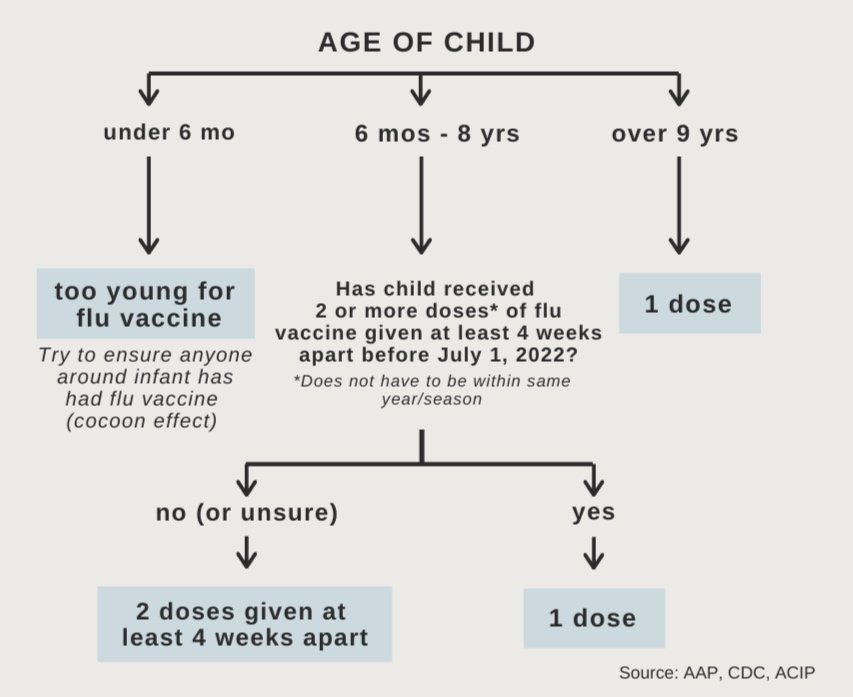The flu vaccine: an overview
Immunization is the most effective way to mitigate the severity of flu infection, but there are many misconceptions about the flu vaccine.
This post discusses answers to some common FAQs from parents about flu vaccines, along with some basic information about who should get the vaccine and when. For more info about influenza in children, see this post.
Flu vaccine formulation
The influenza vaccine is an unusual one in the sense that the formulation is modified from year to year. I’m going to touch on this briefly, but for those who are interested in reliable information about the components, check out this page and this page.
Each year, the strains of circulating influenza virus from the past year are analyzed, with special attention paid to those in the Southern Hemisphere. Using this information, predictions are made about the 4 strains most likely to circulate during our flu season (October-May), and these 4 strains are put into the annual flu vaccine.
We have good data showing that even if the formulation is not spot on, if a vaccinated person gets infected, they still tend to have a shorter, milder course than an unvaccinated person. In one study in children during a flu season where the vaccine did not match the circulating strain, vaccination still decreased the risk of critical illness in kids by 75% (PMID: 35024795). In another study, vaccination decreased the risk of hospitalization and ER visits in children by 40-60% (PMID: 33020249), despite circulation of a “drifted” variant (ie a mismatched strain).
We have also had milder-than-normal flu seasons over the past two years, but Australia and South Africa saw more significant and serious seasons this past winter. I think we should gear up for something similar here in the US.
Answers to common questions
Q: Who should get the flu vaccine?
Children aged 6mo and older should receive an annual flu shot, as long as there are no contraindications.
Every year ACIP puts out recommendations for dosing regimens, and the most current guidelines (which are similar to those from past years) recommend that some children get two doses this season.
Q: Who needs two doses?
For influenza, a single exposure to influenza vaccine is, in most cases, INSUFFICIENT to generate a robust enough immune response to effectively fight the virus if your body encounters it.
In young kids, especially, the data shows that a 2nd shot makes protection substantially more effective (approx double! PMID: 26658375, 16991077). That effect is blunted in older children and adults, except in certain specific situations, such as organ transplant recipients.
Q: Which vaccines are available?
There are two types of vaccines available annually:
Injection: These can be manufactured in different ways, and are approved for children 6mo and up. They do not contain live virus.
Nasal spray: This is a live-attenuated (ie contains weakened virus) vaccination that is typically approved for children aged 2y+ who meet specific eligibility criteria.
Q: Which vaccine is “best” to get?
To be honest, both types of vacicnation are effective and safe. The choice is often made based on availability, tolerance (the nasal spray is a good option for children who are very scared of immunizations) and eligibility.
In our family, we usually do the injectable vaccination. I often worry about whether or not nasal congestion (which is rampant this time of year) might affect absorption of the vaccination in the nasal spray, and truthfully my children don't handle something being sprayed up their noses well. With that said as the children get older, I may be more open to letting them choose.
Q: When should we get the vaccine?
Your goal is to make sure you are protected in October.
For infants and children who need 2 doses, September is an ideal time to start the regimen. Those children will need 2 doses separated by 4 weeks, and will achieve protection 2 weeks after the second dose.
For older children and adults, early October is an ideal time for vaccination.
Q: Can my child get other shots at the same time?
Yes! It is fine to get the flu vaccine at the same time as other routine vaccinations, including the COVID vax.
Q: What if my child has an egg allergy?
They can still get a flu shot. If you are concerned, talk to your pediatrician and/or allergist.
Q: Wait! The flu vaccine gave me the flu! Is this possible?
The Pediatrician Mom Note: The flu vaccine cannot give you the flu
However, some people experience transient flu-like symptoms, such as body aches, headache, chills or fever.
These symptoms are actually indicative of the immune response of your body, should only last 1-2 days, and will be alleviated with Acetaminophen/Ibuprofen and fluids.
More serious allergic reactions can occur, but these are very rare. Check out the CDC website for more info on these.
Q: Is there anything else I can do to help my child’s immune system? Should I buy supplements?
To be honest, the evidence for supplements is not really robust. Here are some thoughts.
Q: What about elderberry?
Read my post on it here.
My infant is getting his first flu shot this week, and the rest of the family will get it in early October, so my hope is that we’ll all be protected by the end of October.
If you haven’t scheduled yours, now is the time! I hope this post helped ease your mind and debunk some of the common flu vaccine myths that are out there.





